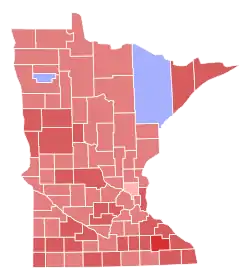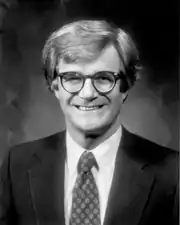1978 United States Senate election in Minnesota
The 1978 United States Senate election in Minnesota was held on November 7, 1978. Incumbent Democratic U.S. Senator Wendell Anderson was defeated by Republican challenger Rudy Boschwitz.
| |||||||||||||||||
| |||||||||||||||||
 County Results Boschwitz: 40-50% 50-60% 60-70% 70-80% Anderson: 40–50% | |||||||||||||||||
| |||||||||||||||||
| Elections in Minnesota |
|---|
 |
The "Minnesota Massacre"
In 1978, Minnesota's top three statewide offices were all up for election: the governorship and both U.S. Senate seats. But there was a particular oddity to the races: the incumbents, each a member of the Democratic-Farmer-Labor Party, were all appointed to their offices, not elected. (Republicans took advantage of this, putting up billboards that read, "The DFL is going to face something scary — an election".)
First, after Walter Mondale was elected Vice President in 1976, sitting Governor Wendell Anderson resigned so that Lieutenant Governor Rudy Perpich, as the new governor, could appoint Anderson to the open seat. This did not sit well with the electorate. Then, in January 1978, Minnesota's other Senate seat opened up when Hubert Humphrey died; Perpich appointed Humphrey's widow, Muriel, to the office. But she did not want to run that fall, and the DFL nominated Bob Short for the post.
Though Democrats maintained large majorities in both the U.S. House and Senate, the November election was something of a disappointment for them, as they lost a handful of seats in both chambers. But for Minnesota's DFL it was a disaster, later dubbed the "Minnesota Massacre". Plywood magnate Rudy Boschwitz campaigned as a liberal Republican, freely spent his own money, and defeated Anderson by 16 points, while David Durenberger crushed Short by 26 points. Al Quie completed the Republican trifecta by downing Perpich 52% to 45%. (Perpich would be reelected governor in 1982 and 1986.) It was the first time the GOP had held all three offices since Joseph H. Ball left the Senate in January 1949.
Democratic–Farmer–Labor primary
Declared
- Daryl W. Anderson
- Wendell Anderson, Incumbent U.S. Senator since 1976
- Dick Bullock
- John S. Connolly
- Emil L. Moses
- Lloyd M. Roberts
Results
| Party | Candidate | Votes | % | |
|---|---|---|---|---|
| Democratic (DFL) | Wendell Anderson (incumbent) | 286,209 | 56.9% | |
| Democratic (DFL) | John S. Connolly | 159,974 | 31.8% | |
| Democratic (DFL) | Daryl W. Anderson | 23,159 | 4.6% | |
| Democratic (DFL) | Lloyd M. Roberts | 12,709 | 2.5% | |
| Democratic (DFL) | Dick Bullock | 11,485 | 2.3% | |
| Democratic (DFL) | Emil L. Moses | 9,580 | 1.9% | |
| Total votes | 503,116 | 100.0% | ||
Independent-Republican primary
Declared
- Rudy Boschwitz, Businessman
- Harold Stassen, Former Governor of Minnesota (1939-1943)
Results
| Party | Candidate | Votes | % | |
|---|---|---|---|---|
| Ind.-Republican | Rudy Boschwitz | 185,393 | 86.8% | |
| Ind.-Republican | Harold Stassen | 28,170 | 13.2% | |
| Total votes | 213,563 | 100.0% | ||
American Party primary
Declared
- Sal Carlone
General election
Results
| Party | Candidate | Votes | % | |
|---|---|---|---|---|
| Ind.-Republican | Rudy Boschwitz | 894,092 | 56.57% | |
| Democratic (DFL) | Wendell Anderson (incumbent) | 638,375 | 40.39% | |
| American | Sal Carlone | 23,261 | 1.47% | |
| Socialist Workers | William Peterson | 9,856 | 0.62% | |
| Independent | Brian J. Coyle | 8,083 | 0.51% | |
| Workers League | Jean T. Brust | 3,891 | 0.25% | |
| Libertarian | Leonard J. Richards | 2,992 | 0.19% | |
| Others | Write-ins | 72 | 0.01% | |
| Total votes | 1,580,622 | 100.0% | ||
| Majority | 255,717 | 16.18% | ||
| Turnout | 1,580,622 | 62.95 | ||
| Ind.-Republican gain from Democratic (DFL) | ||||
See also
References
- "Minnesota Election Results 1978 (Primary Election)" (PDF). Minnesota Secretary of State. Retrieved October 21, 2017.
- http://www.ourcampaigns.com/RaceDetail.html?RaceID=5315
- Clerk of the United States House of Representatives (1979). "Statistics of the Congressional Election of November 7, 1978" (PDF). U.S. Government Printing Office.

